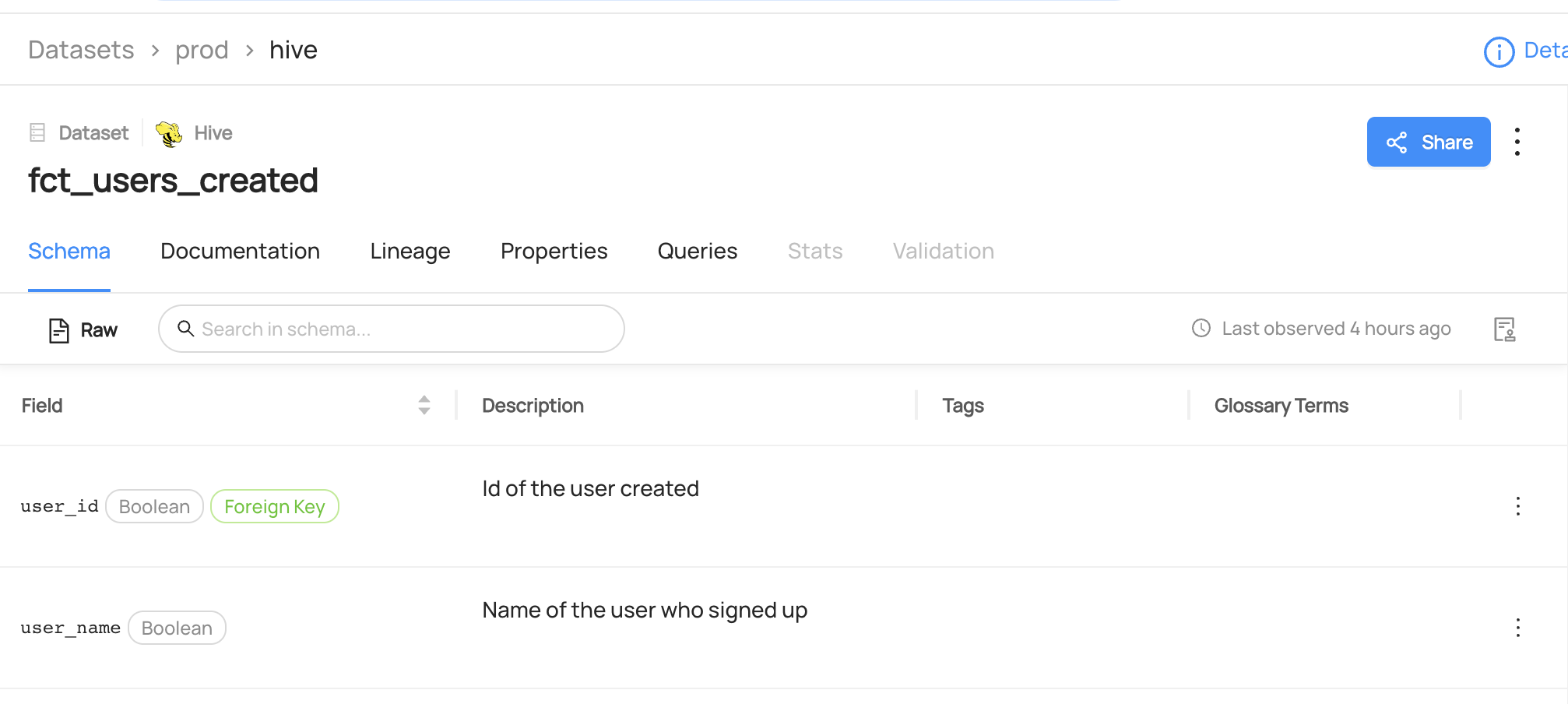Removing Terms From Datasets/Columns
Why Would You Remove Terms?
The Business Glossary(Term) feature in DataHub helps you use a shared vocabulary within the orgarnization, by providing a framework for defining a standardized set of data concepts and then associating them with the physical assets that exist within your data ecosystem.
For more information about terms, refer to About DataHub Business Glossary.
Goal Of This Guide
This guide will show you how to remove a term CustomerAccount from the user_name column of a dataset called fct_users_created.
Additionally, we will cover how to remove a term from the dataset or from multiple entities.
Prerequisites
For this tutorial, you need to deploy DataHub Quickstart and ingest sample data. For detailed steps, please refer to Datahub Quickstart Guide.
Before removing terms, you need to ensure the targeted dataset and the term are already present in your datahub.
If you attempt to manipulate entities that do not exist, your operation will fail.
In this guide, we will be using data from a sample ingestion.
Specifically, we will assume that the term CustomerAccount is attached to the user_name column of a dataset fct_users_created.
To learn how to add terms to your own datasets, please refer to our documentation on Adding Terms.
Remove Terms With GraphQL
Please note that there are two available endpoints (:8000, :9002) to access GraphQL.
For more information about the differences between these endpoints, please refer to DataHub Metadata Service
GraphQL Explorer
GraphQL Explorer is the fastest way to experiment with GraphQL without any dependencies.
Navigate to GraphQL Explorer (http://localhost:9002/api/graphiql) and run the following query.
mutation removeTerm {
removeTerm(
input: {
termUrn: "urn:li:glossaryTerm:CustomerAccount",
resourceUrn: "urn:li:dataset:(urn:li:dataPlatform:hive,fct_users_created,PROD)",
subResourceType:DATASET_FIELD,
subResource:"user_name"})
}
Note that you can also remove a term from a dataset if you don't specify subResourceType and subResource.
mutation removeTerm {
removeTerm(
input: {
termUrn: "urn:li:glossaryTerm:CustomerAccount",
resourceUrn: "urn:li:dataset:(urn:li:dataPlatform:hive,fct_users_created,PROD)",
})
}
Also note that you can remove terms from multiple entities or subresource using batchRemoveTerms.
mutation batchRemoveTerms {
batchRemoveTerms(
input: {
termUrns: ["urn:li:glossaryTerm:CustomerAccount"],
resources: [
{ resourceUrn:"urn:li:dataset:(urn:li:dataPlatform:hdfs,SampleHdfsDataset,PROD)"} ,
{ resourceUrn:"urn:li:dataset:(urn:li:dataPlatform:hive,fct_users_created,PROD)"} ,]
}
)
}
If you see the following response, the operation was successful:
{
"data": {
"removeTerm": true
},
"extensions": {}
}
CURL
With CURL, you need to provide tokens. To generate a token, please refer to Access Token Management.
With accessToken, you can run the following command.
curl --location --request POST 'http://localhost:8080/api/graphql' \
--header 'Authorization: Bearer <my-access-token>' \
--header 'Content-Type: application/json' \
--data-raw '{ "query": "mutation removeTerm { removeTerm(input: { termUrn: \"urn:li:glossaryTerm:CustomerAccount\", resourceUrn: \"urn:li:dataset:(urn:li:dataPlatform:hdfs,SampleHdfsDataset,PROD)\" }) }", "variables":{}}'
Expected Response:
{ "data": { "removeTerm": true }, "extensions": {} }
Remove Terms With Python SDK
The following code removes a term named Legacy from shipment_info column of a dataset called SampleHdfsDataset.
Coming Soon!
We're using the MetdataChangeProposalWrapper to change entities in this example.
For more information about the MetadataChangeProposal, please refer to MetadataChangeProposal & MetadataChangeLog Events
Expected Outcomes
You can now see CustomerAccount term has been removed to user_name column.

